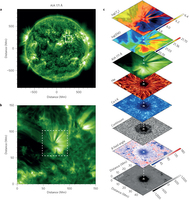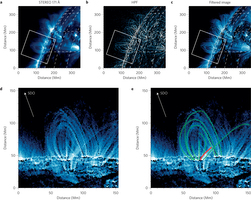.


Queen’s University Belfast lead research milestone in helping predict solar flares
An international team of researchers, led by Queen’s University, has devised a high-precision method of examining magnetic fields in the Sun’s atmosphere, representing a significant leap forward in the investigation of solar flares and potentially catastrophic ‘space weather’.
Solar flares are massive explosions of energy in the Sun’s atmosphere. Experts have warned that even a single ‘monster’ solar flare could cause up to $2 trillion worth of damage on Earth, including the loss of satellites and electricity grids, as well the potential knock-on dangers to human life and health. A key goal of the $300 million Daniel K Inouye Solar Telescope (DKIST), which will be the largest solar telescope in the world when construction is finished in 2019 on the Pacific island of Maui, is the measurement of magnetic fields in the outer regions of the Sun’s atmosphere.
The technique pioneered by the Queen’s-led team, published today in the journal Nature Physics, will feed into the DKIST project, as well as allowing greater advance warning of potentially devastating space storms. The new techniqueallows changes in the Sun’s magnetic fields, which drive the initiation of solar flares, to be monitored up to ten times faster than previous methods.
The Queen’s-led team, which spans academics from universities in Europe, the Asia-Pacific and the USA, harnessed data from both NASA’s premier space-based telescope (the Solar Dynamics Observatory), and the ROSA multi-camera system, which was designed at Queen’s University Belfast, using detectors made by Northern Ireland company Andor Technology.
Lead researcher Dr David Jess from Queen’s Astrophysics Research Centre said: “Continual outbursts from our Sun, in the form of solar flares and associated space weather, represent the potentially destructive nature of our nearest star. Our new techniques demonstrate a novel way of probing the Sun’s outermost magnetic fields, providing scientists worldwide with a new approach to examine, and ultimately understand, the precursors responsible for destructive space weather.
“Queen’s is increasingly becoming a major player on the astrophysics global stage. This work highlights the strong international links we have with other leading academic institutes from around the world, and provides yet another example of how Queen’s research is at the forefront of scientific discovery.”
The paper, entitled ‘Solar Coronal Magnetic Fields Derived Using Seismology Techniques Applied to Omnipresent Sunspot Waves’, can be read at: http://www.nature.com/doifinder/10.1038/nphys3544
Specific research results include:
(1) The datasets used provided unprecedented images of all layers of the Sun’s tenuous atmosphere, allowing the team to piece the jigsaw puzzle together of how magnetic fields permeate the dynamic atmosphere. Images captured by NASA’s Solar Dynamics Observatory and STEREO spacecrafts provided million-degree vantage points of how these magnetic fields stretch far out into the Sun’s corona (the region of the Sun’s atmosphere visible during total solar eclipses)
(2) Waves propagated along magnetic fields, similar to how sound waves travel through the air on Earth. The speed at which these waves can travel is governed by the characteristics of the Sun’s atmosphere, including its temperature and the strength of its magnetic field. The waves were found to propagate with speeds approaching half a million (500,000) mph, and when coupled with temperatures of around 1,000,000 degrees in the Sun’s outer atmosphere, the researchers were able to determine the magnetic field strengths to a high degree of precision
(3) The strength of the magnetic fields decreases by a factor of 100 as they travel from the surface of the Sun out into the tenuous, hot corona. While the magnetic fields have decreased in strength, they still possess immense energy that can twist and shear, ultimately releasing huge blasts towards Earth in the form of solar flares. The team’s methods provide a much faster way of examining magnetic field changes in the lead up to solar flares, which can ultimately be used to provide advanced warning against such violent space weather
4154 Views
